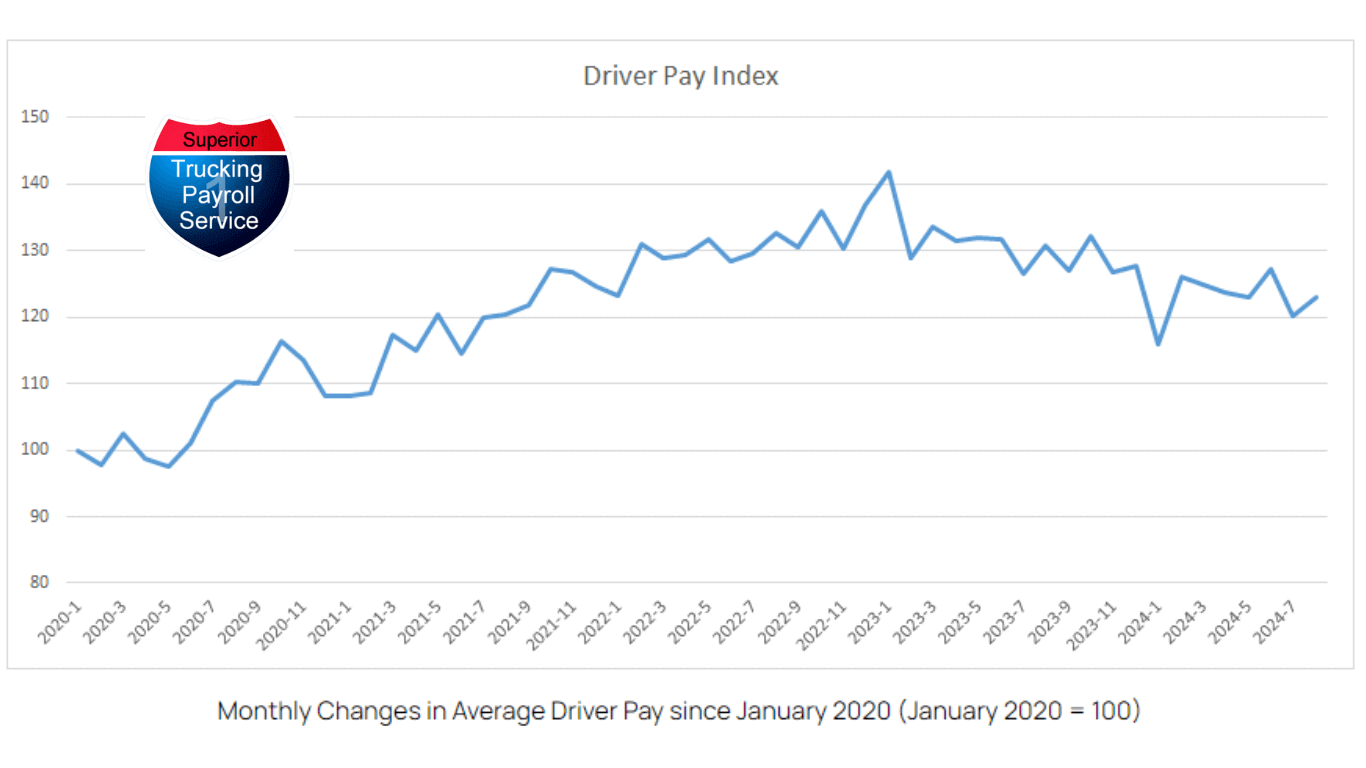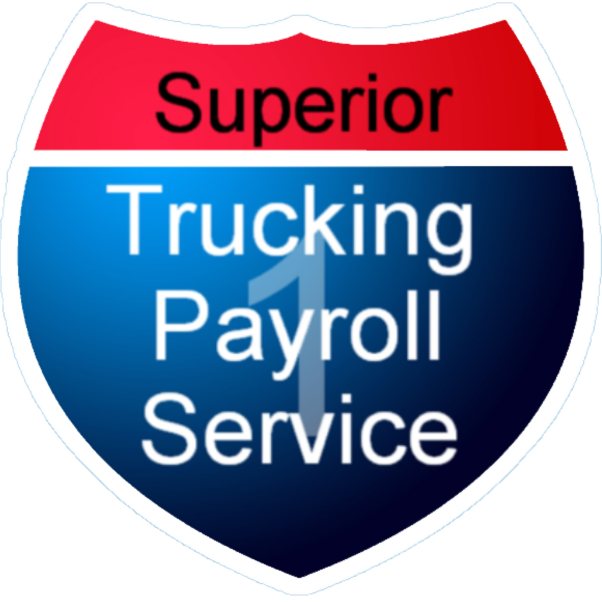Understanding the Rollercoaster of Driver Pay
With pay dropping after historic highs, many drivers and companies are struggling to stay afloat, facing difficult choices like pay cuts and layoffs. This shift has been sudden and hard to manage for many drivers and trucking companies. You might be feeling uncertain about the future, unsure of how to plan for your business or personal finances. You’re not alone—these are tough times for everyone in the industry.
At Superior Trucking Payroll Service, we’re the only U.S.-based payroll service that focuses specifically on the trucking industry. With over 15 years of industry expertise, we have created specialized tools like the Driver Wage Index. We have been monitoring driver wage trends in order to support companies through tough times and are offering clear monthly insights into market shifts.
The trucking industry has faced a sharp decline from 2023 to 2024 in freight rates and driver pay. Understanding what’s driving these changes is critical so you can stay prepared. You’ll learn why pay has dropped, what the industry’s future holds, and actionable steps you can take to secure your financial stability.
Why Truck Driver Pay Spiked: 2020-2022 Trends
Before we focus on the changes of 2023 and beyond, let’s take a brief look at what led up to it. From 2020 to 2022, truck driver pay saw a steady increase. This was mainly due to a combination of high freight demand, skyrocketing freight rates, and what many believed to be a shortage of drivers. The COVID-19 pandemic played a major role in pushing demand for deliveries, with more goods needing to be transported than ever before.
During this time, trucking companies were offering higher pay and bonuses to attract drivers in a competitive market. This led to a period of rapid growth in driver wages, making it seem like there was no end in sight. By the end of 2022, driver pay had reached levels many thought would last for the long haul.
But as 2023 began, the industry started to experience a shift, setting the stage for the challenges that followed.
Based on data from Superior Trucking Payroll Service clients, this graph shows the driver pay trend from 2020 to mid-2024.

You are welcome to use this graph, provided you credit Superior Trucking Payroll Service, and include a link to this page. The graph, including our logo, may not be edited or altered in any way. This data may not be used behind paywalls or registration walls, and it cannot be utilized for commercial purposes.
2023 Truck Driver Pay: Why It Peaked and Declined
At the start of 2023, high freight rates started to go down. This marked the beginning of major changes in the trucking industry. Companies that were used to earning more during the freight boom were now facing shrinking revenues. While many businesses hoped the drop in freight rates would be temporary, it became clear that the high demand and premium rates of the previous years were not coming back as quickly as expected.
Trucking Companies Struggle to Maintain Operating Costs
Through the end of 2022 and much of 2023, trucking companies held onto the hope that freight rates would bounce back. They absorbed the cost of the high driver wages despite declining freight rates. Many companies relied on funds from the Paycheck Protection Program (PPP) and Employee Retention Credit (ERC) to sustain these wages. This helped them hang on longer than they might have otherwise. However, as this went on for over a year, it became increasingly difficult to maintain these high wage levels.
Truck Driver Pay Peaks Briefly Before Decline
In early 2023, driver pay hit its highest point but lasted only a short time. As companies dealt with lower freight rates and still needed to pay drivers, a major change was coming. The trucking industry was about to face a big shift, and wages were set to drop as the pressure grew.
As the year progressed, it became clear that companies could no longer sustain these high wages.
Late 2023: The Financial Struggle and Decline of Trucking Companies
By the end of 2023, the strain was too much, especially for smaller trucking companies. The expected rebound in freight rates did not happen, and many companies couldn’t afford to keep paying high wages with rising costs. Many companies had to make tough choices, like cutting driver pay or shutting down.
Freight Rates Plummet, Pressuring Wages
Freight rates, which had been high for several years, kept dropping throughout 2023. This meant trucking companies were making less money on each load they delivered. With less revenue coming in, it was hard for companies to maintain the pay increases they had offered during the boom. Many companies were forced to cut back to stay in business.
Rising Costs Force Pay Cuts in Trucking
At the same time, other expenses like fuel, truck maintenance, and insurance were going up. These rising costs put even more pressure on companies to cut back wherever they could, and wages became one of the first places to make adjustments. Even for larger companies with more resources, it became clear that paying top dollar for drivers was no longer sustainable.
Small Trucking Companies Struggle to Survive
Smaller trucking companies, in particular, faced tough choices. Without the financial backing that bigger companies had, many small operations had to reduce driver pay or, in some cases, close down completely. The drop in freight rates hit these companies hard, as they were already struggling to cover basic costs. For these companies, the pay cuts weren’t about staying competitive—but about survival.

2024 Driver Pay: Adjusting to the New Normal
By the end of 2024, driver pay had dropped, and the industry had to adjust to this “new normal.” With companies cutting costs, drivers faced tougher competition for the few high-paying jobs left. Some companies tried to soften the blow by offering flexible schedules or bonuses for long-term drivers. Still, these benefits did not replace the higher wages.
The closure of many small trucking companies also reduced the number of available jobs, forcing drivers to lower their expectations. For many, this meant accepting lower pay or taking on extra work to make up for lost income.
The Decline and What’s Next
In recent years, driver pay rates in the trucking industry have gone up and down for many reasons. Pay rose to new heights because of high demand and competition for drivers, then fell as companies dealt with lower freight rates and rising costs.
Today, driver pay rates have settled into a more stable range but they are lower than before. This new “normal” is not what anyone wanted. Trucking companies face lower freight rates and higher costs, forcing them to make tough choices. Drivers also face a more competitive job market where high-paying jobs are harder to find. Both companies and drivers are adjusting to these challenges, even though it means making sacrifices. It’s a hard adjustment for everyone, but understanding these changes is the first step to moving forward.
Trends suggest that the industry will improve over time, with freight rates expected to rise again. This gives hope that better days are ahead for both companies and drivers. However, this recovery will take time. Patience is vital as the market slowly adjusts.
In the meantime, companies and drivers must focus on finding ways to survive now. By staying informed and adapting to changes, they can be ready to take advantage of growth when the industry rebounds.
Stay Informed with Superior Trucking Payroll Service’s Truck Driver Pay Index
Use our Truck Driver Pay Index to stay updated on wage trends and take proactive steps for your business.

Written by Mike Ritzema
Before founding Superior Trucking Payroll Service, Mike was the CFO of a trucking company with 80 trucks and a thriving brokerage. This experience gave him the perspective that a payroll solution has to make the lives of the office people better. All the solutions he has designed are to benefit everyone. Our company mission is to help trucking families and that includes the company owners, the drivers, and the office.

